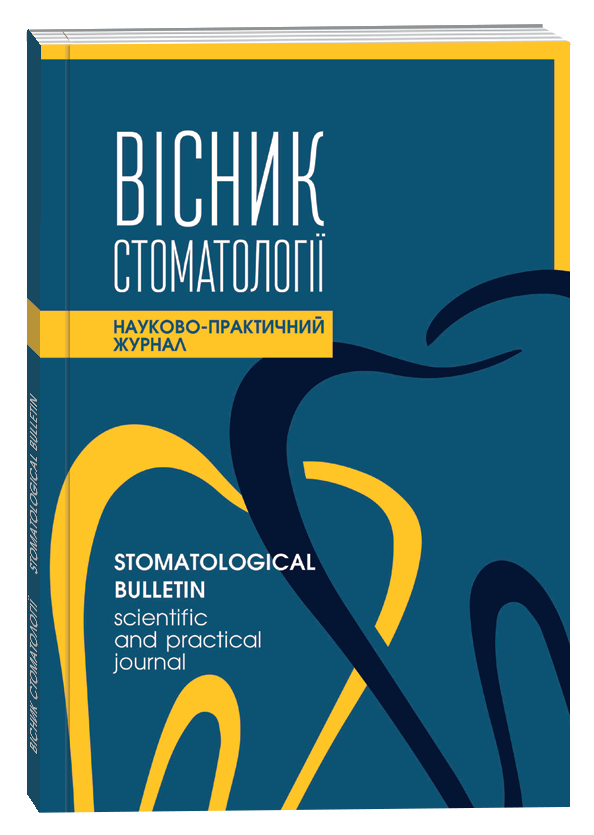CLINICAL MANIFESTATIONS OF HIV INFECTION IN THE ORAL CAVITY IN CHILDREN
DOI:
https://doi.org/10.35220/2078-8916-2021-40-2.13Keywords:
HIV infection, children, diseases of the oral cavityAbstract
The aim of the study was to analyze the features of clinical manifestations of HIV infection in the oral cavity in children. Research methods. Analysis and generalization of literature data about the features of clinical manifestations of HIV infection in the oral cavity in children. Scientific novelty. Systematization of medical and diagnostic aspects of lesions of the oral mucosa, salivary glands and periodontal tissues, which affect the course of the disease. This will allow to develop a pathogenetic scheme of treatment and prevention measures, which will improve the quality of life of HIV-infected children. Conclusions. Candidal stomatitis is diagnosed in most AIDS patients (up to 75%) and manifests in several clinical forms: angular cheilitis, erythematous, hyperplastic or pseudomembranous candidiasis. It is believed to be suspected of having HIV infection and requires laboratory testing for HIV if there is the “sudden” development of candidiasis in children who have not previously received antibiotics or corticosteroids. Bacterial infections in HIV-infected children are often caused by associations of various pathogens (fusospirochetes, streptococci and staphylococci). Manifestations of these infections can be gingivitis, HIV-necrotic lesions of the gums or mucous membranes of the cheeks, palate, HIV-chronic periodontitis. Viral infections often contribute to lesions of the oral mucosa in HIV-infected patients. Among the viral infections in the clinical symptoms of HIV-infected people are lesions of the oral mucosa caused by the herpes simplex virus. “Hairy” leukoplakia occurs in 98% of HIV patients and is a marker of the disease. The origin of “hairy” leukoplakia is associated with a high level of replication of Epstein- Barr virus in the epithelial cells of the tongue. Salivary gland damage in children with HIV is much more common than in adults. They increase and swell, hyperplastic changes appear.
References
Lauritano D., Moreo G., Oberti L., Lucchese A., Di Stasio D., Conese M., Carinci F. Oral Manifestations in HIV-Positive Children: A Systematic Review. Pathogens. 2020. № 9(2). Р. 88–95.
Сундукова К.А., Кисельникова Л.П., Гаджикулиева М.М. Проявление ВИЧ-инфекции в полости рта у детей. Российский медицинский журнал. 2016. Том 22, № 6. С. 329–331.
Запорожан В.М., Аряєв М.Л. ВIЛ-iнфекцiя i СНIД: 2-е вид., перероб. i доп. Київ : Здоров’я, 2004. 636 с.
Ottria L., Lauritano D., Oberti L., Candotto V., Cura F., Tagliabue A., Tettamanti L. Prevalence of HIV-related oral manifestations and their association with HAART and CD4+ T cell count: a review. J Biol Regul Homeost Agents. 2018. № 32. Р. 51–59.
Луцкая И.К., Зиновенко О.Г., Андреева В.А. Проявления ВИЧ-инфицирования (СПИД) на слизистой оболочке полости рта у детей. Consilium medicum/Педиатрия. 2015. № 3. С. 18–22.
Искакова М.К., Жартыбаев Р.Н., Джандаулетова Н.Б., Бедрикова Е.А., Мырзахметова Г.Б., Орманова А.А. Ретроспективный анализ стоматологического здоровья у ВИЧ-инфицированных детей. Вестник КазНМУ. 2016. №4. С. 166–170.
Халилаева Е.В., Подымова А.С. Особенности клинических проявлений ВИЧ-инфекции в полости рта и их зависимость от иммуносупрессии. Здоровье населения и среда обитания. 2009. № 12. С. 17–18.
Суржанський С.К., Трофимець Е.К., Агафонова Г.Ю. Особенности стоматологического статуса у ВИЧ-позитивных пациентов. Вісник стоматології. 2003. № 3. С. 15–17.
Santos L.C., Castro G.F., de Souza I.P., Oliveira R.H. Oral manifestations related to immunosuppression degree in HIV-positive children. Braz. Dent. J. 2001. № 12(2). Р. 135–138.
Шатохин А.И. Особенности иммунологических и биохимических показателей слюны при ВИЧ-инфекции. Пародонтология. 2008. №4 (49). С. 22–25.
Петрушанко Т.О., Іленко Н.В. Особливості стану тканин пародонта, імунологічних та біохімічних змін ротової рідини ВІЛ–інфікованих. Актуальні проблеми сучасної медицини. 2013. Т. 13, Вип. 2 (42). С. 46–49.
Клінічні та стоматологічні аспекти ВІЛ-інфекції/СНІДу: навчальний посібник для студентів стомат. фак-тів ВМНЗ IV рівня акредитації, лікарів-інтернівстоматологів та лікарів стомат. профілю / І.І. Соколова, С.І. Герман, О.Ю. Стоян та ін. Харків: ХНМУ, 2011. 152 с.
Єрошенко Г.А., Шевченко К.В., Крамаренко Д.Р. Структурно-функціональні особливості слинних залоз змішаної секреції. Вісник проблем біології і медицини. 2019. Вип. 2, т. 1 (150). С. 22–26.
Mandel L., Surattanont F. Regression of HIV parotid swellings after antiviral therapy: case reports with computed tomographic scan evidence. Oral Surg. Oral Med. Oral Pathol. Oral Radiol. Endod. 2002. № 94(4). Р. 454–459.
Navazesh M., Mulligan R., Karim R., Mack W.J., Ram S., Seirawan H. et al. Effect of HAART on salivary gland function in the Women’s Interagency HIV Study (WIHS). Oral Dis. 2009. № 15(1). Р. 52–60.
Mohamed N., Mathiba O.P., Mulder R. Oral status of HIV-infected children aged 12 years or younger who attended a Paediatric Infectious Diseases Clinic in Cape Town. Clin Exp Dent Res. 2020. № 6(1). Р. 75–81.
Shanmugavadivel G., Senthil Eagappan A.R., Dinesh S., Balatandayoudham A., Sadish M., Kumar P.P. Dental caries status of children receiving Highly active antiretroviral therapy (HAART) – A multicentric crosssectional study in Tamil Nadu, India. J Family Med Prim Care. 2020. № 9(12). Р. 6147–6152.
Cavasin Filho J.C., Giovani E.M. Xerostomy, dental caries and periodontal disease in HIV + patients. Braz. J. Infect. Dis. 2009. №13(1). Р. 13–17.









